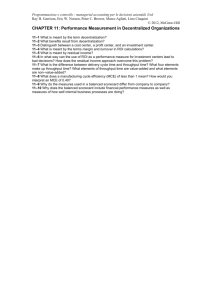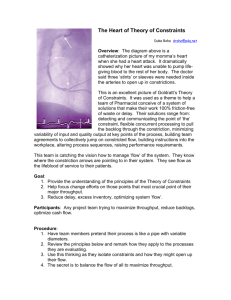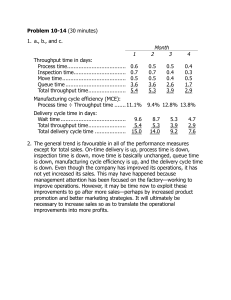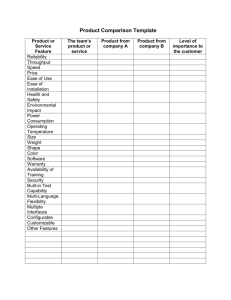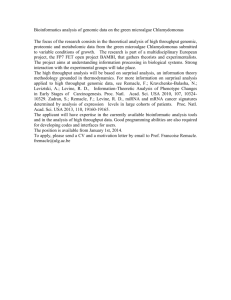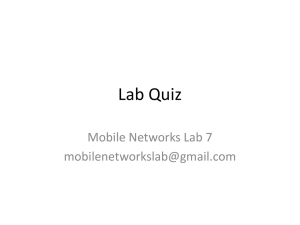The Sixteenth Computational Intelligence Reading of IEEE SMC
advertisement
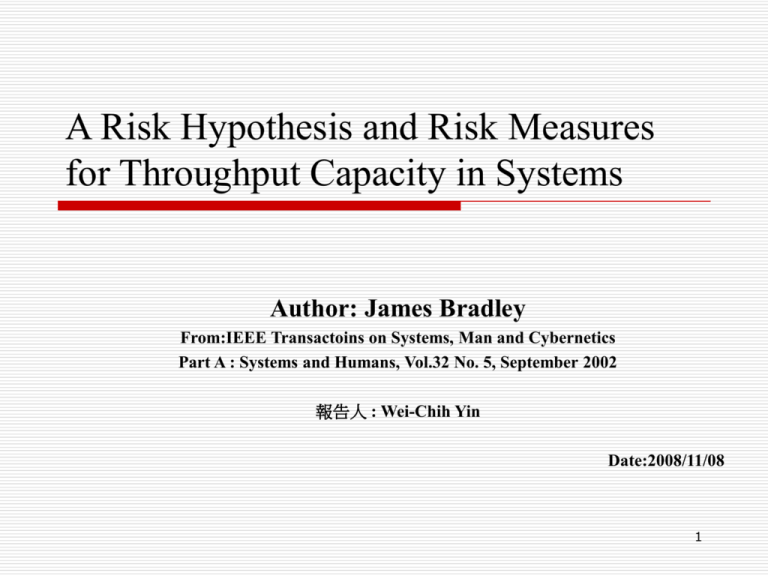
A Risk Hypothesis and Risk Measures for Throughput Capacity in Systems Author: James Bradley From:IEEE Transactoins on Systems, Man and Cybernetics Part A : Systems and Humans, Vol.32 No. 5, September 2002 報告人 : Wei-Chih Yin Date:2008/11/08 1 Outline Section 1. Introduction Section 2. Overview of risk equation and support equations Section 3. Risk and resources Section 4. Risk and throughput capacity Section 5. Concluding remarks 2 Section 1. Introduction Complex systems increasingly have to cope with risk in their operating environment. Some systems are exposed to risk whose source is intrinsic. Such systems are all human-agent directed systems. In this paper, we present a hypothesis, expressed as a risk equation, that relates system throughput capacity to system resources and risk. 3 Section 1. Introduction Definitions of Risk In engineering: Risk = ( probability of an accident ) * ( losses per accident) In more general terms: Risk = (probability of event occuring ) * ( impact of event occuring ) 4 Section 2. Overview of risk equation and support equations Part A. Systems and System Throughput Capacity Part B. Basic Resource Equation and Axiomatic Foundation Part C. Resource-Sharing Equation Part D. Basic Risk Equation 5 Section 2. Part A. Systems and System Throughput Capacity 1. A system is considered to be any entity that generates outputs from inputs. 2. Inputs can be another system or human. 3. The definitions are as below: R : Resource E : Environment U : A output set is generated from a input set per unit time. (is also the system throughput) I : I is the throughput capacity of the system 6 Section 2. Part B. Basic Resource Equation and Axiomatic Foundation The basic resource equation is I=K*R where K is a constant. It states that throughput increases linearly with resource of the same type. It seems to be implicit in the nature of things, and so, we take it as axiomatic. 7 Section 2. Part C. Resource-Sharing Equation Under sharing of the system resources, throughput capacity is given by I = K * R * (1+S) 0, there is no sharing and only one thread is active. S (Sharing level) : n, means that thre ads are active. 8 Section 2. Part D. Basic Risk Equation In this paper, we concerned only positive risk equation. I = RK + Rcr(E) – Rr(E) = R[K+(c-1)r(E)] = R[K+br(E)]. I : a mean or expected throughput capacity r(E) : risk per unit R; risk of loss of throughput capacity c : constant, risk efficiency coefficient b : constant, risk sensitivity coefficient 9 Section 3. Risk and resources To grasp the concept of risk, one must grasp the distinction between exposure to the certainty of future loss and exposure to merely the possibility of future loss. Exposure to future loss is involved in both cases, but only exposure to the possibility of future loss is a source of risk. For example, a system may be exposed to a future throughput capacity loss of 30, but if a future loss of 10 is certain, there is only risk of loss of 20, at worst. 10 Section 3. Risk and resources (cont.) Risk Measures : Suppose further that the statistics are constant or stationary and that if we compute over a period of time long enough to be fully representative of these statistics, we get a mean or expected throughput capacity Im. Suppose further that over such a representative time period, we get the following n throughput capacity values: 11 Section 3. Risk and resources (cont.) Here, the downward deviations L1 ,L2 ,… are losses down from , Im and deviations G1, G2,… are gains up from Im , with n = i + j , so that 12 Section 3. Risk and resources (cont.) Standard-Deviation (SD) Risk Measure: Compute the standard deviation of the deviations (L1, L2,…G1,G2,.. ) from Im, and take this as a standard deviation measure of possible loss with respect to Im. This is the standard-deviation or SD-risk measure. Use of twice the standard deviation gives an even more conservative risk measure, called the 2-standarddeviations or 2-SD-risk measure. 13 Section 3. Risk and resources (cont.) MEL(mean expected loss)-Risk Measure: We use the mean of these loss deviations from the hazard-free throughput capacity as a risk measure. We call this measure the mean expected loss (MEL) with respect to , or down from, the throughput capacity obtaining in any time period where the hazard risked does not occur at all. However, there are two extreme possibilities with regard to what is to be considered as for a hazard-free time period. One is Natural, or explicit, hazard-free case; the other is Artificial or implicit hazard-free case. 14 Section 4. Risk and throughput capacity In this section, we derive the basic risk equation. We show that, for a risk r(E), the expected throughput capacity is given by 15 Section 4. Risk and throughput capacity (cont.) Efficient Environments and Linear Relationship Between Throughput and Risk Consider now two systems environments E1 and E2. Suppose E1 is risk-free, in which the system, with resources R, has a stable throughput capacity I=KR per time unit. Environment E2 is the same as E1, except that in E2, there is risk. Suppose gross throughput capacity in E2 is KR+G per time unit, in each of one or more time periods, in which we run the risk in E2, but where, by good fortune, it just happens that the hazard we risked does not occur. We can therefore look at KR+G as the hazard-free throughput capacity in the presence of risk. 16 Section 4. Risk and throughput capacity (cont.) We could borrow additional R resources, at the cost KR of the risk-free throughput from the borrowed R, and apply them to E2. The throughput capacity will now be (2KR+2(G-Lr)-KR) for the system, or KR+2G2Lr, on average. So the extra throughput capacity for agent’s resources will be 2(G-Lr), on average, with the MEL-risk being 2Lr.This is consistent with throughput capacity increasing linearly with risk. It follows that, in general, expected throughput capacity I is given by Here, is the MEL-risk, and and are independent agent controlled variables, where . The factor will vary with the synthetic environment chosen for the system by the agent. 17 Section 5. Concluding remarks Since the risk equation and resource sharing equation are valid only for agent-directed, nongrowth, nonevolving Systems. An obvious area for future research is development of similar equations for agent-directed systems that allow for system growth and evolution. 18 Thank You ! 19

